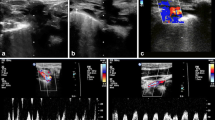Abstract
Determining the clinical impact of imaging exams at the enterprise level is problematic, as radiology reports historically have been created with the content meant primarily for the referring provider. Structured reporting can establish the foundation for enterprise monitoring of imaging outcomes without manual review providing the framework for assessment of utilization and quality. Ultrasound (US) for deep vein thrombosis evaluation (DVT) is an ideal testbed for assessing this functionality. The system standard template for Doppler US for extremity venous evaluation for DVT was updated with a discrete fixed picklist of impression options and implemented system wide. Template utilization and interpretive outcomes were actively monitored and use reinforced as part of standard clinical practice. From January 1, 2017 to December 31, 2017, 9111 US exams for DVT were performed with 8997 utilizing structured reporting (98.75%). Of those in the structured reporting group, 1074 (11.79%) were positive for any type of DVT with 732 (8.03%) reported as Acute/New above the knee. Positive rates for any type of DVT were 10.29% emergency department, 14.17% inpatient, and 13.20% outpatient. While being the lowest positive rate, the emergency department had the highest overall volume of exams. Structured reporting for DVT US assessment outcomes can be implemented with a very high rate of radiologist adoption and adherence providing accurate determination of positive rates, month by month, in differing patient locations. Structured elements can be used to automatically trigger downstream processes; in our institution, this will alert providers in the EHR if the patient does not receive anticoagulation within 2 h of a positive test. This lays the foundation for effective enterprise assessment of imaging outcomes forming the basis of future quality and safety initiatives on optimizing health system resource utilization.






Similar content being viewed by others
References
Kahn, Jr CE, Langlotz CP, Burnside ES, Carrino JA, Channin DS, Hovsepian DM et al.: Toward best practices in radiology reporting. Radiology 252(3):852–856, 2009
Dunnick NR, Langlotz CP: The radiology report of the future: a summary of the 2007 Intersociety Conference. J Am Coll Radiol 5(5):626–629, 2008
Alkasab TK, Bizzo BC, Berland LL, Nair S, Pandharipande PV, Harvey HB: Creation of an open framework for point-of-care computer-assisted reporting and decision support tools for radiologists. J Am Coll Radiol 14(9):1184–1189, 2017
Pons E, Braun LM, Hunink MG, Kors JA: Natural language processing in radiology: a systematic review. Radiology 279(2):329–343, 2016
McGinty GB, Allen, Jr B, Geis JR, Wald C: IT infrastructure in the era of imaging 3.0. J Am Coll Radiol 11(12 Pt B):1197–1204, 2014
Brook OR, Brook A, Vollmer CM, Kent TS, Sanchez N, Pedrosa I: Structured reporting of multiphasic CT for pancreatic cancer: potential effect on staging and surgical planning. Radiology 274(2):464–472, 2015
Reiner BI, Knight N, Siegel EL: Radiology reporting, past, present, and future: the radiologist’s perspective. J Am Coll Radiol 4(5):313–319, 2007
Suh-Burgmann EJ, Flanagan T, Lee N, Osinski T, Sweet C, Lynch M, Caponigro M, Mehta J, Alavi M, Herrinton LJ: Large-scale implementation of structured reporting of adnexal masses on ultrasound. J Am Coll Radiol 15(5):755–761, 2018
Jenkins HJ, Downie AS, Maher CG, Moloney NA, Magnussen JS, Hancock MJ: Imaging for low back pain: is clinical use consistent with guidelines? A systematic review and meta-analysis. Spine J, 2018. https://doi.org/10.1016/j.spinee.2018.05.004
ACR. ACR Appropriateness Criteria May, 2018 [Available from: https://www.acr.org/Clinical-Resources/ACR-Appropriateness-Criteria
Nass SJ, Patlak M, National Cancer Policy Forum (U.S.): Assessing and improving the interpretation of breast images : workshop summary. Washington, DC: The National Academies Press, 2015, xx, 73 pages p
Pinto Dos Santos D, Scheibl S, Arnhold G, Maehringer-Kunz A, Duber C, Mildenberger P et al.: A proof of concept for epidemiological research using structured reporting with pulmonary embolism as a use case. Br J Radiol, 2018. https://doi.org/10.1259/bjr.20170564
Larson PA, Berland LL, Griffith B, Kahn, Jr CE, Liebscher LA: Actionable findings and the role of IT support: report of the ACR Actionable Reporting Work Group. J Am Coll Radiol 11(6):552–558, 2014
Johnson AJ, Chen MY, Zapadka ME, Lyders EM, Littenberg B: Radiology report clarity: a cohort study of structured reporting compared with conventional dictation. J Am Coll Radiol 7(7):501–506, 2010
Author information
Authors and Affiliations
Corresponding author
Rights and permissions
About this article
Cite this article
Browning, T., Giri, S., Peshock, R. et al. Utilization of Structured Reporting to Monitor Outcomes of Doppler Ultrasound Performed for Deep Vein Thrombosis. J Digit Imaging 32, 401–407 (2019). https://doi.org/10.1007/s10278-018-0131-6
Published:
Issue Date:
DOI: https://doi.org/10.1007/s10278-018-0131-6




